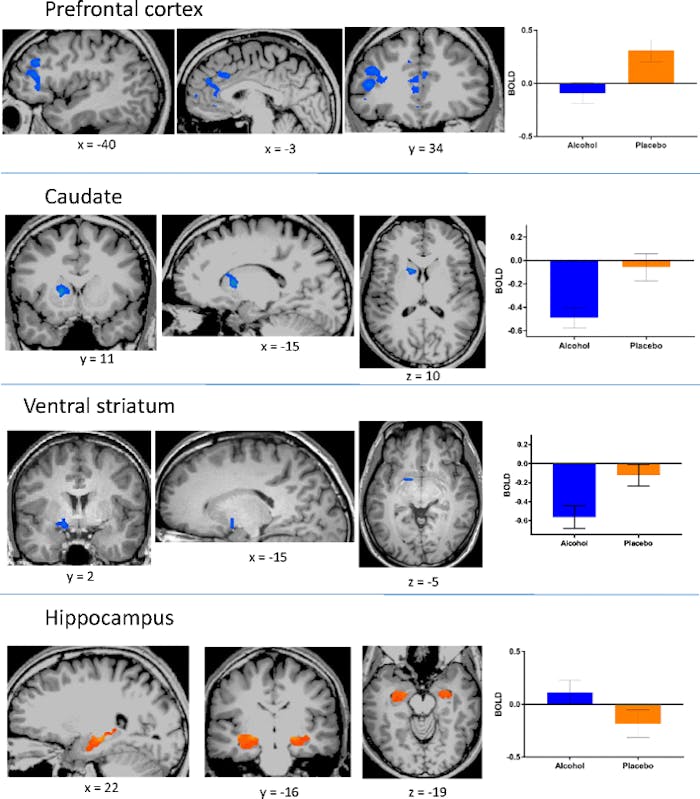We all have that friend who gets a little out of hand when they start drinking alcohol. Maybe he gets loud, or maybe she starts fights with strangers for looking at her funny. Alcohol seems to induce aggression, changing the brain in a way that makes a drunk person more likely to see minor social cues as threats, but how it does so has always been a bit of biological mystery.

But in a paper published in the journal Cognitive, Affective, & Behavioral Neuroscience, a team of researchers led by Thomas Denson, Ph.D., of the University of New South Wales School of Psychology use brain scans to show that alcohol changes activity in certain key parts of the brain related to aggression and emotion.
Using functional magnetic resonance imaging (fMRI), a technique that tracks changes in blood flow in the brain, the team looked at the brains of 50 young men after they consumed either two alcoholic drinks or two non-alcoholic placebo drinks. These volunteers engaged in a task that gauged their level of aggression in the face of provocation, which revealed the parts of the brain that become more active in such situations.

The researchers found that alcohol-induced aggression was correlated with decreased activity in prefrontal cortex, caudate, and ventral striatum, but increased activity in the hippocampus. These parts of the brain all control key factors in aggression: The prefrontal cortex is associated with thoughtful action and social behavior, the caudate is linked to the brain’s reward system and inhibitory control, and the ventral striatum is a part of the reward system that makes you feel good when you do something good. The hippocampus, meanwhile, is associated with emotion and memory.
These results support previous hypotheses that prefrontal cortex dysfunction is associated with alcohol-induced aggression. Taking all these brain areas together, the researchers say their findings suggest that intoxicated people have trouble processing information through their working memory. In short, they suspect that alcohol focuses a person’s attention on the cues that could instigate aggression while taking attention away from their knowledge of social norms that say violence is not acceptable.
Along similar lines, they also suspect that alcohol could make relatively minor cues seem aggressive or violent, which can cause a drunk person to overreact to a minor incident, like someone looking at them funny or accidentally bumping into them at the bar. Denson’s previous research on the angry brain found a lot of overlap in the way the prefrontal cortex behaves when someone is drunk and angry versus when they’re simply ruminating on their anger while sober.
This research proposes some possible brain biomarkers for alcohol-induced aggression, which is a significant public health issue. According to the Centers for Disease Control and Prevention, in the United States, alcohol-related violence — including homicide, child abuse, suicide, and firearm injuries — was responsible for more than 16,000 deaths between 2006 and 2010, the most recent years the agency reported figures.
While the new study doesn’t propose a solution per se, it does build on our body of knowledge around an age-old question: Why do some people become assholes when they get drunk?
Abstract: Alcohol intoxication is implicated in approximately half of all violent crimes. Over the past several decades, numerous theories have been proposed to account for the influence of alcohol on aggression. Nearly all of these theories imply that altered functioning in the prefrontal cortex is a proximal cause. In the present functional magnetic resonance imaging (fMRI) experiment, 50 healthy young men consumed either a low dose of alcohol or a placebo and completed an aggression paradigm against provocative and nonprovocative opponents. Provocation did not affect neural responses. However, relative to sober participants, during acts of aggression, intoxicated participants showed decreased activity in the prefrontal cortex, caudate, and ventral striatum, but heightened activation in the hippocampus. Among intoxicated participants, but not among sober participants, aggressive behavior was positively correlated with activation in the medial and dorsolateral prefrontal cortex. These results support theories that posit a role for prefrontal cortical dysfunction as an important factor in intoxicated aggression.



